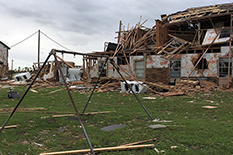
|
 |
Texas home hit by Hurricane Harvey. |
|
Rapid damage assessments typically used to guide recovery after a severe windstorm could also improve efforts to understand building failures and mitigate damage from future events. That is the conclusion of two case studies conducted in part by Center for Disaster Resilience post doctoral associate Richard Krupar III and recently published in the Australian Journal of Emergency Management.
The research, led by James Cook University’s Daniel Smith, examines data on characteristics like building type, degree of damage, and pressing hazards collected immediately after Tropical Cyclone Debbie in 2017 and a supercell thunderstorm that hit Brisbane, Australia in 2014 to help those leading the recovery prioritize their actions.
Smith and Krupar, along with co-authors David Henderson from the Cyclone Testing Station at James Cook University and The University of Queensland’s Matthew Mason, discovered that the datasets provide a clearer picture of the spatial extent and relative frequency of the damage. Rapid damage assessment and Doppler radar data from Brisbane, for example, revealed that wind damage was most frequent at the leading edge of the thunderstorm gust front. The results also pinpointed the most frequent location of hail damage, a discovery that may help scientists forecast the position of hail stones in real time and begin building models that predict what damage may be experienced.
Rapid damage assessment datasets could additionally shine a light on the vulnerability of various building types and components—such as gutters—which could in turn help communities and homeowners avoid future damage with targeted upgrades.
“The rapid damage assessments could be further improved by incorporating more engineering-relevant data, which would include, but is not limited to, information on the building construction type, percentage of cladding and roof loss, percentage of doors and windows that failed, and flood or storm surge inundation heights,” said Krupar.
The value of these assessments was demonstrated again earlier this year when Krupar, David Roueche from Auburn University, and Frank Lombardo from the University of Illinois at Urbana–Champaign led a reconnaissance of Texas communities hit by Hurricane Harvey. Initial results revealed that similar residential buildings exposed to the same hazard conditions unexpectedly sustained varying levels of damage.
The research team was given a National Science Foundation Rapid Response Research award to develop a method engineers and scientists could use to better anticipate wind, storm surge and joint wind-storm surge damage.
Related Articles:
Nationwide Urban Flooding Disrupts Local Economies, Public Safety, and Housing Equity
What Does a Pair of Dice Have to Do With Disaster Recovery?
UMD Resilience Experts Awarded NSF Grant to Accelerate Disaster Recovery
National Academies Committee Led by CEE Professor Outlines Framework to Protect Residents from Mount St. Helens Legacy
Research Spearheaded by UMD Receives NSF RAPID Support
Wind Engineers Complete Proof of Concept for New Structural Design Method
Climate Change: A Threat Multiplier?
Researchers: Hurricanes Disproportionately Affect Renters
Niemeier Named Center for Disaster Resilience Director
Allison Reilly Wins NSF CAREER Award
November 29, 2017
|

